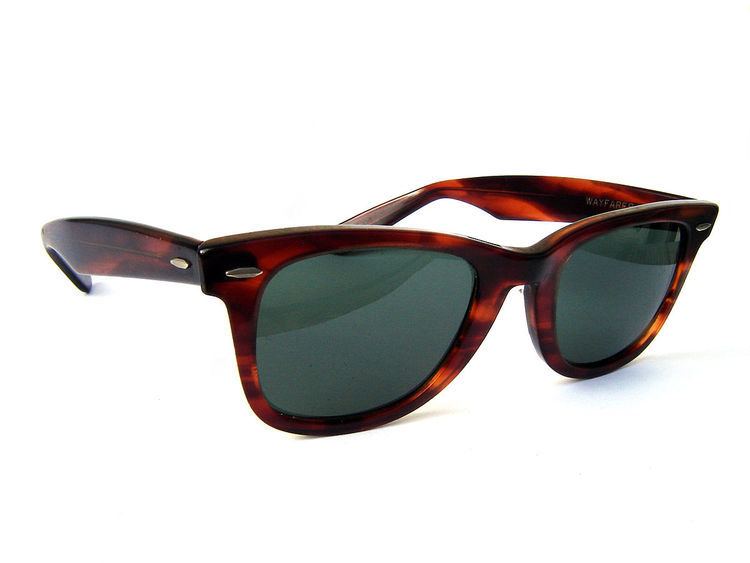 | ||
Ray-Ban Wayfarer sunglasses have been manufactured by Ray-Ban since 1956, which in turn has belonged to the Italian Luxottica Group since 1999. Wayfarers enjoyed early popularity in the 1950s and 1960s, returning to popularity again after a 1982 product placement. A second revival occurred in the mid-2000s.
Contents
Design and early popularity
Wayfarers were designed in 1952 by American optical designer Raymond Stegeman, who worked for Bausch and Lomb, Ray-Ban's parent company at that time. The design was inspired by, "a mid-century classic to rival Eames chairs and Cadillac tail fins." According to design critic Stephen Bayley, the "distinctive trapezoidal frame spoke a non-verbal language that hinted at unstable dangerousness, but one nicely tempered by the sturdy arms which, according to the advertising, gave the frames a 'masculine look.'" Ray-Ban Wayfarers, also used a new plastic molding technology.
1970s and 1980s
After Wayfarers' heyday in the 1950s and 1960s, sales declined. Though Wayfarers' cultural popularity was aided in 1980 by the film The Blues Brothers, only 18,000 pairs were sold in 1981, and Wayfarers were on the verge of discontinuation. In 1982 Ray-Ban signed a $50,000-a-year deal with Unique Product Placement of Burbank, California, to place Ray-Bans in movies and television shows. Between 1982 and 1987, Ray-Ban sunglasses appeared in over 60 movies and television shows per year, an effort continued through 2007. Tom Cruise's wearing of Wayfarers in the 1983 movie Risky Business was one of the key placements, and that year 360,000 pairs were sold. Additional appearances in movies like Miami Vice, Moonlighting, and The Breakfast Club, led sales to 1.5 million annually.
Wayfarers were also worn during performances by musicians, including Michael Jackson, Billy Joel, Johnny Marr, Blondie's Debbie Harry, Madonna, Depeche Mode, Elvis Costello, and members of U2 and Queen, as well as public figures such as artificial intelligence Max Headroom, Jack Nicholson, and Anna Wintour.
Bret Easton Ellis' fiction contained references to Wayfarers. Lyrics that mentioned the style of glasses included Don Henley's 1984 song "The Boys Of Summer", which contained the lyric "You got that hair slicked back and those Wayfarers on, baby". Corey Hart's music video Sunglasses At Night shows the artists wearing Wayfarers in darkness. In response to these placements, Ray-Ban's Wayfarer expanded from two models in 1981 to about 40 models by 1989.
1990s
As the 1990s began, the frames again became unpopular. The 1950s revival that fueled the glasses' popularity in the 1980s lost momentum, and Wayfarers were outcompeted by wraparound frames. During the slump of the 1990s, Ray-Ban's parent company, Bausch & Lomb was facing pressure from competitors like Oakley. In 1999, Bausch & Lomb along with Ray-Ban was purchased by Luxottica Group S.p.A. of Italy for $640 million. In 2001, the Wayfarer underwent a significant redesign (RB2132), with the frames made smaller and less angular, and changed from acetate to a lighter injected plastic. The changes were intended to update the frames' style during a period of unpopularity and to make them easier to wear (the frames' previous tilt made them impossible to perch on top of one's head, for instance).
2000s
Wayfarers were brought back into fashion in the late 2000s when public figures including Chloë Sevigny and Mary-Kate Olsen began wearing vintage frames. When Ray-Ban noticed that vintage Wayfarers were selling for significant prices on eBay, a 2007 re-introduction of the original Wayfarer (RB2140) design was initiated. The RB2140 model is identical to the original B&L5022 model, except the metal "studs" on the temple arms were replaced with the Ray-Ban logo and the right lens now bears the logo as well. (As of 2007, Wayfarers were available in Original Wayfarer, New Wayfarer, and Wayfarer Folding styles.) Ray-Ban's marketing strategy was threefold: a return to the sunglasses' original, rebellious design, an "edgy" advertising campaign and "high-profile PR events", and the use of new media like MySpace to connect with consumers. Sales in 2007 were 231% greater than in 2006 at Selfridge's London; as of October 2007, the Wayfarer was the Luxottica Group's third-best-selling style.
Similar designs
During the 2000s Wayfarer revival, many sunglasses designs inspired by the original Wayfarers were produced by designers unaffiliated with Ray-Ban. Grey Ant's Grant Krajecki designed a larger, cartoonish version of the glasses "so extreme that [they] are best worn by those with a good sense of humor". Other Wayfarer-inspired sunglasses included Oliver Peoples' Hollis, REM Eyewear's Converse, and various designs in Juicy Couture, Hugo Boss, Kate Spade, Marc Jacobs's and Kaenon Polarized 2008 lines. Between July and September 2008, retailers began selling frameless Wayfarers.
